Deck 4: Polynomial and Rational Functions Applications to Optimization
سؤال
سؤال
سؤال
سؤال
سؤال
سؤال
سؤال
سؤال
سؤال
سؤال
سؤال
سؤال
سؤال
سؤال
سؤال
سؤال
سؤال
سؤال
سؤال
سؤال
سؤال
سؤال
سؤال
سؤال
سؤال

فتح الحزمة
قم بالتسجيل لفتح البطاقات في هذه المجموعة!
Unlock Deck
Unlock Deck
1/25
العب
ملء الشاشة (f)
Deck 4: Polynomial and Rational Functions Applications to Optimization
1
Find all fixed points of the function.
A) x = 17
B) x = 0, x = 170
C) x = 10
D) x = 17, x = 10
E) no fixed points
A) x = 17
B) x = 0, x = 170
C) x = 10
D) x = 17, x = 10
E) no fixed points
x = 17
2
Suppose that the revenue generated by selling x units of a certain commodity is given by . Assume that R is in dollars. What is the maximum revenue possible in this situation?
A) $450,000
B) $440,000
C) $430,000
D) $900,000
E) $480,000
A) $450,000
B) $440,000
C) $430,000
D) $900,000
E) $480,000
$450,000
3
Sketch the graph of the function and specify all x- and y-intercepts. y = - 3x 4 + 5
A)![<strong>Sketch the graph of the function and specify all x- and y-intercepts. y = - 3x<sup> 4 </sup> + 5</strong> A) x-intercepts: 5 Y-intercept: - 50,625 B) x-intercepts: -5 Y-intercept: - 50,625 C) x-intercepts: - \sqrt [ 4 ] { \frac { 5 } { 3 } } , \sqrt [ 4 ] { \frac { 5 } { 3 } } Y-intercept: - 5 D) x-intercepts: - \sqrt [ 4 ] { \frac { 5 } { 3 } } , \sqrt [ 4 ] { \frac { 5 } { 3 } } Y-intercept: 5 E) x-intercept: 0 Y-intercept: 0](https://d2lvgg3v3hfg70.cloudfront.net/TB3314/11ea9528_0447_3f4f_9016_2526f7e2a392_TB3314_00.jpg) x-intercepts: 5
x-intercepts: 5
Y-intercept: - 50,625
B)![<strong>Sketch the graph of the function and specify all x- and y-intercepts. y = - 3x<sup> 4 </sup> + 5</strong> A) x-intercepts: 5 Y-intercept: - 50,625 B) x-intercepts: -5 Y-intercept: - 50,625 C) x-intercepts: - \sqrt [ 4 ] { \frac { 5 } { 3 } } , \sqrt [ 4 ] { \frac { 5 } { 3 } } Y-intercept: - 5 D) x-intercepts: - \sqrt [ 4 ] { \frac { 5 } { 3 } } , \sqrt [ 4 ] { \frac { 5 } { 3 } } Y-intercept: 5 E) x-intercept: 0 Y-intercept: 0](https://d2lvgg3v3hfg70.cloudfront.net/TB3314/11ea9528_0447_6660_9016_d98d1015147c_TB3314_00.jpg) x-intercepts: -5
x-intercepts: -5
Y-intercept: - 50,625
C)![<strong>Sketch the graph of the function and specify all x- and y-intercepts. y = - 3x<sup> 4 </sup> + 5</strong> A) x-intercepts: 5 Y-intercept: - 50,625 B) x-intercepts: -5 Y-intercept: - 50,625 C) x-intercepts: - \sqrt [ 4 ] { \frac { 5 } { 3 } } , \sqrt [ 4 ] { \frac { 5 } { 3 } } Y-intercept: - 5 D) x-intercepts: - \sqrt [ 4 ] { \frac { 5 } { 3 } } , \sqrt [ 4 ] { \frac { 5 } { 3 } } Y-intercept: 5 E) x-intercept: 0 Y-intercept: 0](https://d2lvgg3v3hfg70.cloudfront.net/TB3314/11ea9528_0447_8d71_9016_ffd93f7a0475_TB3314_00.jpg) x-intercepts:
x-intercepts:
Y-intercept: - 5
D)![<strong>Sketch the graph of the function and specify all x- and y-intercepts. y = - 3x<sup> 4 </sup> + 5</strong> A) x-intercepts: 5 Y-intercept: - 50,625 B) x-intercepts: -5 Y-intercept: - 50,625 C) x-intercepts: - \sqrt [ 4 ] { \frac { 5 } { 3 } } , \sqrt [ 4 ] { \frac { 5 } { 3 } } Y-intercept: - 5 D) x-intercepts: - \sqrt [ 4 ] { \frac { 5 } { 3 } } , \sqrt [ 4 ] { \frac { 5 } { 3 } } Y-intercept: 5 E) x-intercept: 0 Y-intercept: 0](https://d2lvgg3v3hfg70.cloudfront.net/TB3314/11ea9528_0447_b483_9016_c5398aae1028_TB3314_00.jpg) x-intercepts:
x-intercepts:
Y-intercept: 5
E)![<strong>Sketch the graph of the function and specify all x- and y-intercepts. y = - 3x<sup> 4 </sup> + 5</strong> A) x-intercepts: 5 Y-intercept: - 50,625 B) x-intercepts: -5 Y-intercept: - 50,625 C) x-intercepts: - \sqrt [ 4 ] { \frac { 5 } { 3 } } , \sqrt [ 4 ] { \frac { 5 } { 3 } } Y-intercept: - 5 D) x-intercepts: - \sqrt [ 4 ] { \frac { 5 } { 3 } } , \sqrt [ 4 ] { \frac { 5 } { 3 } } Y-intercept: 5 E) x-intercept: 0 Y-intercept: 0](https://d2lvgg3v3hfg70.cloudfront.net/TB3314/11ea9528_0447_b485_9016_bd234b2b1241_TB3314_00.jpg) x-intercept: 0
x-intercept: 0
Y-intercept: 0
A)
![<strong>Sketch the graph of the function and specify all x- and y-intercepts. y = - 3x<sup> 4 </sup> + 5</strong> A) x-intercepts: 5 Y-intercept: - 50,625 B) x-intercepts: -5 Y-intercept: - 50,625 C) x-intercepts: - \sqrt [ 4 ] { \frac { 5 } { 3 } } , \sqrt [ 4 ] { \frac { 5 } { 3 } } Y-intercept: - 5 D) x-intercepts: - \sqrt [ 4 ] { \frac { 5 } { 3 } } , \sqrt [ 4 ] { \frac { 5 } { 3 } } Y-intercept: 5 E) x-intercept: 0 Y-intercept: 0](https://d2lvgg3v3hfg70.cloudfront.net/TB3314/11ea9528_0447_3f4f_9016_2526f7e2a392_TB3314_00.jpg) x-intercepts: 5
x-intercepts: 5Y-intercept: - 50,625
B)
![<strong>Sketch the graph of the function and specify all x- and y-intercepts. y = - 3x<sup> 4 </sup> + 5</strong> A) x-intercepts: 5 Y-intercept: - 50,625 B) x-intercepts: -5 Y-intercept: - 50,625 C) x-intercepts: - \sqrt [ 4 ] { \frac { 5 } { 3 } } , \sqrt [ 4 ] { \frac { 5 } { 3 } } Y-intercept: - 5 D) x-intercepts: - \sqrt [ 4 ] { \frac { 5 } { 3 } } , \sqrt [ 4 ] { \frac { 5 } { 3 } } Y-intercept: 5 E) x-intercept: 0 Y-intercept: 0](https://d2lvgg3v3hfg70.cloudfront.net/TB3314/11ea9528_0447_6660_9016_d98d1015147c_TB3314_00.jpg) x-intercepts: -5
x-intercepts: -5Y-intercept: - 50,625
C)
![<strong>Sketch the graph of the function and specify all x- and y-intercepts. y = - 3x<sup> 4 </sup> + 5</strong> A) x-intercepts: 5 Y-intercept: - 50,625 B) x-intercepts: -5 Y-intercept: - 50,625 C) x-intercepts: - \sqrt [ 4 ] { \frac { 5 } { 3 } } , \sqrt [ 4 ] { \frac { 5 } { 3 } } Y-intercept: - 5 D) x-intercepts: - \sqrt [ 4 ] { \frac { 5 } { 3 } } , \sqrt [ 4 ] { \frac { 5 } { 3 } } Y-intercept: 5 E) x-intercept: 0 Y-intercept: 0](https://d2lvgg3v3hfg70.cloudfront.net/TB3314/11ea9528_0447_8d71_9016_ffd93f7a0475_TB3314_00.jpg) x-intercepts:
x-intercepts: Y-intercept: - 5
D)
![<strong>Sketch the graph of the function and specify all x- and y-intercepts. y = - 3x<sup> 4 </sup> + 5</strong> A) x-intercepts: 5 Y-intercept: - 50,625 B) x-intercepts: -5 Y-intercept: - 50,625 C) x-intercepts: - \sqrt [ 4 ] { \frac { 5 } { 3 } } , \sqrt [ 4 ] { \frac { 5 } { 3 } } Y-intercept: - 5 D) x-intercepts: - \sqrt [ 4 ] { \frac { 5 } { 3 } } , \sqrt [ 4 ] { \frac { 5 } { 3 } } Y-intercept: 5 E) x-intercept: 0 Y-intercept: 0](https://d2lvgg3v3hfg70.cloudfront.net/TB3314/11ea9528_0447_b483_9016_c5398aae1028_TB3314_00.jpg) x-intercepts:
x-intercepts: Y-intercept: 5
E)
![<strong>Sketch the graph of the function and specify all x- and y-intercepts. y = - 3x<sup> 4 </sup> + 5</strong> A) x-intercepts: 5 Y-intercept: - 50,625 B) x-intercepts: -5 Y-intercept: - 50,625 C) x-intercepts: - \sqrt [ 4 ] { \frac { 5 } { 3 } } , \sqrt [ 4 ] { \frac { 5 } { 3 } } Y-intercept: - 5 D) x-intercepts: - \sqrt [ 4 ] { \frac { 5 } { 3 } } , \sqrt [ 4 ] { \frac { 5 } { 3 } } Y-intercept: 5 E) x-intercept: 0 Y-intercept: 0](https://d2lvgg3v3hfg70.cloudfront.net/TB3314/11ea9528_0447_b485_9016_bd234b2b1241_TB3314_00.jpg) x-intercept: 0
x-intercept: 0Y-intercept: 0
![x-intercepts: - \sqrt [ 4 ] { \frac { 5 } { 3 } } , \sqrt [ 4 ] { \frac { 5 } { 3 } } Y-intercept: 5](https://d2lvgg3v3hfg70.cloudfront.net/TB3314/11ea9528_0447_b483_9016_c5398aae1028_TB3314_00.jpg) x-intercepts:
x-intercepts: Y-intercept: 5
4
Graph the quadratic function. Specify the vertex, axis of symmetry, maximum or minimum value, and intercepts.
A) vertex: (- 2, 0); axis of symmetry: t = - 2; maximum value: 0; t-intercept: - 2; s-intercept: -1.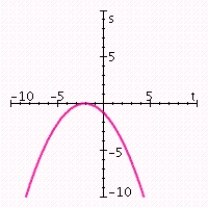
B) vertex: (- 2, 0); axis of symmetry: t = - 2; minimum value: 0; t-intercept: - 2; s-intercept: 1.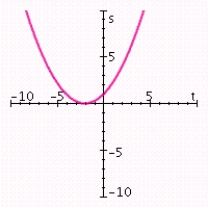
C) vertex: (2, 0); axis of symmetry: t = 2; maximum value: 0; t-intercept: 2; s-intercept: -1.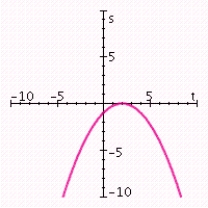
D) vertex: (0,1); axis of symmetry: t = 0; maximum value: 1; t-intercept: ; s-intercept: 1.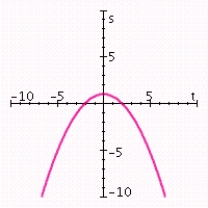
E) vertex: (0, 2);axis of symmetry: t = 0; maximum value: 2; t-intercept: ;s-intercept: 2.
A) vertex: (- 2, 0); axis of symmetry: t = - 2; maximum value: 0; t-intercept: - 2; s-intercept: -1.

B) vertex: (- 2, 0); axis of symmetry: t = - 2; minimum value: 0; t-intercept: - 2; s-intercept: 1.

C) vertex: (2, 0); axis of symmetry: t = 2; maximum value: 0; t-intercept: 2; s-intercept: -1.

D) vertex: (0,1); axis of symmetry: t = 0; maximum value: 1; t-intercept: ; s-intercept: 1.

E) vertex: (0, 2);axis of symmetry: t = 0; maximum value: 2; t-intercept: ;s-intercept: 2.


فتح الحزمة
افتح القفل للوصول البطاقات البالغ عددها 25 في هذه المجموعة.
فتح الحزمة
k this deck
5
Sketch the graph of the function and specify all x- and y-intercepts. y =- ( x - 3) 3 - 1
A)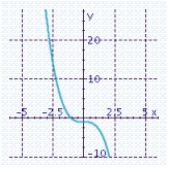 x-intercept: -1
x-intercept: -1
Y-intercept: -1
B) x-intercept: -2
x-intercept: -2
Y-intercept: 26
C)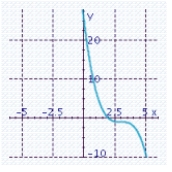 x-intercept: 2
x-intercept: 2
Y-intercept: 26
D)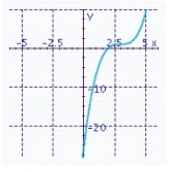 x-intercept: 2
x-intercept: 2
Y-intercept: - 26
E)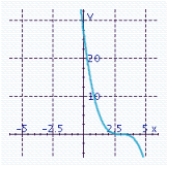 x-intercept: 3
x-intercept: 3
Y-intercept: 27
A)
 x-intercept: -1
x-intercept: -1Y-intercept: -1
B)
 x-intercept: -2
x-intercept: -2Y-intercept: 26
C)
 x-intercept: 2
x-intercept: 2Y-intercept: 26
D)
 x-intercept: 2
x-intercept: 2Y-intercept: - 26
E)
 x-intercept: 3
x-intercept: 3Y-intercept: 27

فتح الحزمة
افتح القفل للوصول البطاقات البالغ عددها 25 في هذه المجموعة.
فتح الحزمة
k this deck
6
A triangle is inscribed in a semicircle of diameter 6R. Show that the smallest possible value for the area of the shaded region is .  Hint: The area of the shaded region is a minimum when the area of the triangle is a maximum. Find the value of x that maximizes the square of the area of the triangle. This will be the same x that maximizes the area of the triangle.
Hint: The area of the shaded region is a minimum when the area of the triangle is a maximum. Find the value of x that maximizes the square of the area of the triangle. This will be the same x that maximizes the area of the triangle.
A) The hint tells us that the area of the region is a minimum when the area of the triangle is a maximum. We first find the value of x that maximizes the square of the area of the triangle. The area of the triangle is equal to .
The square of the area of the triangle is equal to , and the substitution will transform this expression into the quadratic function
Since we want to find the maximum value of t, we will substitute the value into the equation. Solving for t gives us the following minimum area of the shaded region: .
B) The hint tells us that the area of the region is a minimum when the area of the triangle is a maximum. We first find the value of x that maximizes the square of the area of the triangle. The area of the triangle is equal to .
The square of the area of the triangle is equal to The substitution will transform this expression into the quadratic function
Since the graph of equation (1) will be a parabola opening downward, the input t that yields a maximum value for this function is
Substituting the value into the equation gives us and consequently (The negative root can be rejected since the side of a triangle can't be negative). With this value of x, we can calculate the minimum area of the shaded region. The minimum area of the shaded region is equal to
Substituting the value in the equation (2) gives us that the minimum value of the shaded region is equal to .
C) The hint tells us that the area of the region is a minimum when the area of the triangle is a maximum. We first find the value of x that maximizes the square of the area of the triangle. The square of the area of the triangle is equal to .
The substitution will transform this into the quadratic function
Since the graph of equation (1) will be a parabola opening downward, the input t that yields a maximum value for this function is
Substituting the value into the equation gives us and consequently . With this value of x, we can calculate the minimum area of the shaded region. The minimum area of the shaded region is equal to
Substituting the value into the equation (2), we find that the minimum value of the shaded region is equal to .
D) The hint tells us that the area of the region is a minimum when the area of the triangle is a maximum. We first find the value of x that maximizes the square of the area of the triangle.
The square of the area of the triangle is equal to , which is a quadratic function. The graph of this function will be a parabola opening downward, so we can write the maximum value of this function as:
We can then write as and calculate the minimum area of the shaded region. Substituting this value into the area equation, we find its minimum area: .
E) The hint tells us that the area of the region is a minimum when the area of the triangle is a maximum. We first find the value of x that maximizes the square of the area of the triangle. The square of the area of the triangle is equal to .
The substitution will transform this into the quadratic function
Since the graph of equation (1) will be a parabola opening downward, the input t that yields a maximum value for this function is
Substituting the value into the equation gives us and consequently . With this value of x, we can calculate the minimum area of the shaded region. The minimum area of the shaded region is equal to
Substituting the value into the equation (2), we find that the minimum value of the shaded region is equal to .
 Hint: The area of the shaded region is a minimum when the area of the triangle is a maximum. Find the value of x that maximizes the square of the area of the triangle. This will be the same x that maximizes the area of the triangle.
Hint: The area of the shaded region is a minimum when the area of the triangle is a maximum. Find the value of x that maximizes the square of the area of the triangle. This will be the same x that maximizes the area of the triangle.A) The hint tells us that the area of the region is a minimum when the area of the triangle is a maximum. We first find the value of x that maximizes the square of the area of the triangle. The area of the triangle is equal to .
The square of the area of the triangle is equal to , and the substitution will transform this expression into the quadratic function
Since we want to find the maximum value of t, we will substitute the value into the equation. Solving for t gives us the following minimum area of the shaded region: .
B) The hint tells us that the area of the region is a minimum when the area of the triangle is a maximum. We first find the value of x that maximizes the square of the area of the triangle. The area of the triangle is equal to .
The square of the area of the triangle is equal to The substitution will transform this expression into the quadratic function
Since the graph of equation (1) will be a parabola opening downward, the input t that yields a maximum value for this function is
Substituting the value into the equation gives us and consequently (The negative root can be rejected since the side of a triangle can't be negative). With this value of x, we can calculate the minimum area of the shaded region. The minimum area of the shaded region is equal to
Substituting the value in the equation (2) gives us that the minimum value of the shaded region is equal to .
C) The hint tells us that the area of the region is a minimum when the area of the triangle is a maximum. We first find the value of x that maximizes the square of the area of the triangle. The square of the area of the triangle is equal to .
The substitution will transform this into the quadratic function
Since the graph of equation (1) will be a parabola opening downward, the input t that yields a maximum value for this function is
Substituting the value into the equation gives us and consequently . With this value of x, we can calculate the minimum area of the shaded region. The minimum area of the shaded region is equal to
Substituting the value into the equation (2), we find that the minimum value of the shaded region is equal to .
D) The hint tells us that the area of the region is a minimum when the area of the triangle is a maximum. We first find the value of x that maximizes the square of the area of the triangle.
The square of the area of the triangle is equal to , which is a quadratic function. The graph of this function will be a parabola opening downward, so we can write the maximum value of this function as:
We can then write as and calculate the minimum area of the shaded region. Substituting this value into the area equation, we find its minimum area: .
E) The hint tells us that the area of the region is a minimum when the area of the triangle is a maximum. We first find the value of x that maximizes the square of the area of the triangle. The square of the area of the triangle is equal to .
The substitution will transform this into the quadratic function
Since the graph of equation (1) will be a parabola opening downward, the input t that yields a maximum value for this function is
Substituting the value into the equation gives us and consequently . With this value of x, we can calculate the minimum area of the shaded region. The minimum area of the shaded region is equal to
Substituting the value into the equation (2), we find that the minimum value of the shaded region is equal to .

فتح الحزمة
افتح القفل للوصول البطاقات البالغ عددها 25 في هذه المجموعة.
فتح الحزمة
k this deck
7
Plot the following points: (6, 2), (7, 5), (8, 8), (9, 9). In your scatter diagram, sketch a line that best seems to fit the data. Estimate the slope and the y-intercept of the line.
A) Estimated slope: 2; Estimated y-intercept: -12.5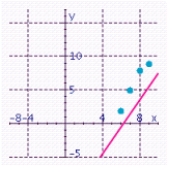
B) Estimated slope: 2.5; Estimated y-intercept: -13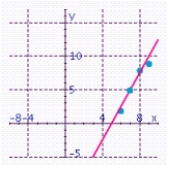
C) Estimated slope: 2.9; Estimated y-intercept: -15.3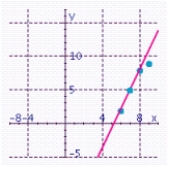
D) Estimated slope: 1.2; Estimated y-intercept: -1.5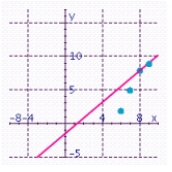
E) Estimated slope: 2.5; Estimated y-intercept: -16
A) Estimated slope: 2; Estimated y-intercept: -12.5

B) Estimated slope: 2.5; Estimated y-intercept: -13

C) Estimated slope: 2.9; Estimated y-intercept: -15.3

D) Estimated slope: 1.2; Estimated y-intercept: -1.5

E) Estimated slope: 2.5; Estimated y-intercept: -16


فتح الحزمة
افتح القفل للوصول البطاقات البالغ عددها 25 في هذه المجموعة.
فتح الحزمة
k this deck
8
Sketch the graph of the function and specify all x- and y-intercepts. y =(x - 2) 2 + 4
A)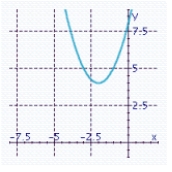 There is no x-intercept. y-intercept: 8
There is no x-intercept. y-intercept: 8
B) There is no x-intercept. y-intercept: 8
There is no x-intercept. y-intercept: 8
C)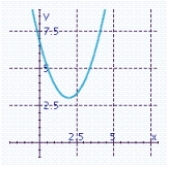 There is no x-intercept. y-intercept: 7
There is no x-intercept. y-intercept: 7
D)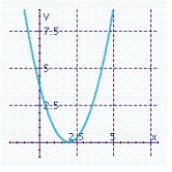 x-intercept: 0 y-intercept: 4
x-intercept: 0 y-intercept: 4
E)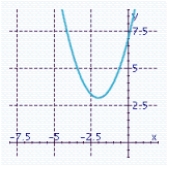 There is no x-intercept. y-intercept: 7
There is no x-intercept. y-intercept: 7
A)
 There is no x-intercept. y-intercept: 8
There is no x-intercept. y-intercept: 8B)
 There is no x-intercept. y-intercept: 8
There is no x-intercept. y-intercept: 8C)
 There is no x-intercept. y-intercept: 7
There is no x-intercept. y-intercept: 7D)
 x-intercept: 0 y-intercept: 4
x-intercept: 0 y-intercept: 4E)
 There is no x-intercept. y-intercept: 7
There is no x-intercept. y-intercept: 7
فتح الحزمة
افتح القفل للوصول البطاقات البالغ عددها 25 في هذه المجموعة.
فتح الحزمة
k this deck
9
What is the largest possible area for a rectangle with a perimeter of 40 cm?
A) 400 cm 2
B) 100 cm 2
C) 90 cm 2
D) 130 cm 2
E) 150 cm 2
A) 400 cm 2
B) 100 cm 2
C) 90 cm 2
D) 130 cm 2
E) 150 cm 2

فتح الحزمة
افتح القفل للوصول البطاقات البالغ عددها 25 في هذه المجموعة.
فتح الحزمة
k this deck
10
Find the linear function satisfying the given conditions. and
A)
B)
C)
D)
E)
A)
B)
C)
D)
E)

فتح الحزمة
افتح القفل للوصول البطاقات البالغ عددها 25 في هذه المجموعة.
فتح الحزمة
k this deck
11
For the following figure, express the length AB as a function of x. (Hint: Note the similar triangles.) 
A)
B)
C)
D)
E)

A)
B)
C)
D)
E)

فتح الحزمة
افتح القفل للوصول البطاقات البالغ عددها 25 في هذه المجموعة.
فتح الحزمة
k this deck
12
Find all fixed points of the function.
A) x = 1
B) x = - 1
C) x = 4
D) x = 3
E) no fixed points
A) x = 1
B) x = - 1
C) x = 4
D) x = 3
E) no fixed points

فتح الحزمة
افتح القفل للوصول البطاقات البالغ عددها 25 في هذه المجموعة.
فتح الحزمة
k this deck
13
A factory owner buys a new machine for $25,000. After eight years, the machine has a salvage value of $1,000. Find a formula for the value of the machine after t years, where
A) V (t) = - 3,000x + 25,000
B) V (t) = - 3,000x + 1,000
C) V (t) = 3,000x + 25,000
D) V (t) = 3,000x - 25,000
E) V (t) = - 3,000x - 25,000
A) V (t) = - 3,000x + 25,000
B) V (t) = - 3,000x + 1,000
C) V (t) = 3,000x + 25,000
D) V (t) = 3,000x - 25,000
E) V (t) = - 3,000x - 25,000

فتح الحزمة
افتح القفل للوصول البطاقات البالغ عددها 25 في هذه المجموعة.
فتح الحزمة
k this deck
14
Sketch the graph of the function and specify all x- and y-intercepts. y = (x - 2)(x - 1)(x + 1)
A)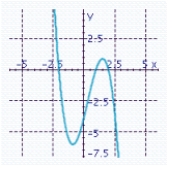 x-intercepts: - 2, 1, 2
x-intercepts: - 2, 1, 2
Y-intercept: -4
B) x-intercepts: - 1, 1, 2
x-intercepts: - 1, 1, 2
Y-intercept: 2
C)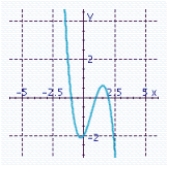 x-intercepts: - 1, 1, 2
x-intercepts: - 1, 1, 2
Y-intercept: -2
D) x-intercepts: - 2, 1, 2
x-intercepts: - 2, 1, 2
Y-intercept: 4
E)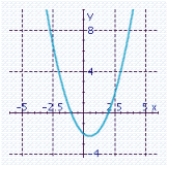 x-intercepts: - 1, 1
x-intercepts: - 1, 1
Y-intercepts: - 2.25
A)
 x-intercepts: - 2, 1, 2
x-intercepts: - 2, 1, 2Y-intercept: -4
B)
 x-intercepts: - 1, 1, 2
x-intercepts: - 1, 1, 2Y-intercept: 2
C)
 x-intercepts: - 1, 1, 2
x-intercepts: - 1, 1, 2Y-intercept: -2
D)
 x-intercepts: - 2, 1, 2
x-intercepts: - 2, 1, 2Y-intercept: 4
E)
 x-intercepts: - 1, 1
x-intercepts: - 1, 1Y-intercepts: - 2.25

فتح الحزمة
افتح القفل للوصول البطاقات البالغ عددها 25 في هذه المجموعة.
فتح الحزمة
k this deck
15
Two points A and B move along the x-axis. After t sec, their positions are given by the equations A:
B: At what time t do A and B have the same x-coordinate?
A) 7 sec
B) 6 sec
C) 5 sec
B: At what time t do A and B have the same x-coordinate?
A) 7 sec
B) 6 sec
C) 5 sec

فتح الحزمة
افتح القفل للوصول البطاقات البالغ عددها 25 في هذه المجموعة.
فتح الحزمة
k this deck
16
Find all fixed points of the function.
A) x = - 1, x = - 9
B) x = - 1, x = 9
C) x = - 9, x = 1
D) x = 9
E) no fixed points
A) x = - 1, x = - 9
B) x = - 1, x = 9
C) x = - 9, x = 1
D) x = 9
E) no fixed points

فتح الحزمة
افتح القفل للوصول البطاقات البالغ عددها 25 في هذه المجموعة.
فتح الحزمة
k this deck
17
Determine the input that produces the largest or smallest output (whichever is appropriate). State whether the output is largest or smallest. s = - 24t 2 + 147t + 15
A) ; largest
B) ; largest
C) ; smallest
D) ; largest
E) ; smallest
A) ; largest
B) ; largest
C) ; smallest
D) ; largest
E) ; smallest

فتح الحزمة
افتح القفل للوصول البطاقات البالغ عددها 25 في هذه المجموعة.
فتح الحزمة
k this deck
18
A piece of wire inches long is bent into a circle. Express the area of the circle as a function of y.
A)
B)
C)
D)
E)
A)
B)
C)
D)
E)

فتح الحزمة
افتح القفل للوصول البطاقات البالغ عددها 25 في هذه المجموعة.
فتح الحزمة
k this deck
19
Suppose that the height of an object shot straight up is given by h =544t - 16t 2 . (Here h is in feet and t is in seconds.) Find the maximum height.
A) 4,724 ft
B) 4,624 ft
C) 1,156 ft
D) 4,290 ft
E) 5,189 ft
A) 4,724 ft
B) 4,624 ft
C) 1,156 ft
D) 4,290 ft
E) 5,189 ft

فتح الحزمة
افتح القفل للوصول البطاقات البالغ عددها 25 في هذه المجموعة.
فتح الحزمة
k this deck
20
Among all rectangles having a perimeter of 24m, find the dimensions of the one with the largest area.
A)
B)
C)
D)
E)
A)
B)
C)
D)
E)

فتح الحزمة
افتح القفل للوصول البطاقات البالغ عددها 25 في هذه المجموعة.
فتح الحزمة
k this deck
21
Sketch the graph of the rational function. Specify the intercepts and the asymptotes.
A) no x-intercepts; y-intercept: 1; no vertical asymptotes; horizontal asymptote: y = 0;
B) no x-intercepts; y-intercept: 1; vertical asymptote: x = 1; horizontal asymptote: y = 0;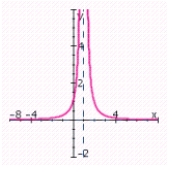
C) no x-intercepts; y-intercept: 1; vertical asymptote: x = - 1; horizontal asymptote: y = 0;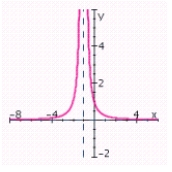
D) no x-intercepts; y-intercept: -1; vertical asymptote: x = 1; horizontal asymptote: y = 0;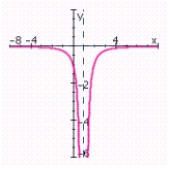
E) no x-intercepts; y-intercept: -1; no vertical asymptotes; horizontal asymptote: y = 0;
A) no x-intercepts; y-intercept: 1; no vertical asymptotes; horizontal asymptote: y = 0;

B) no x-intercepts; y-intercept: 1; vertical asymptote: x = 1; horizontal asymptote: y = 0;

C) no x-intercepts; y-intercept: 1; vertical asymptote: x = - 1; horizontal asymptote: y = 0;

D) no x-intercepts; y-intercept: -1; vertical asymptote: x = 1; horizontal asymptote: y = 0;

E) no x-intercepts; y-intercept: -1; no vertical asymptotes; horizontal asymptote: y = 0;


فتح الحزمة
افتح القفل للوصول البطاقات البالغ عددها 25 في هذه المجموعة.
فتح الحزمة
k this deck
22
Sketch the graph of the function and specify all x- and y-intercepts.y = x 3 - 9x
A)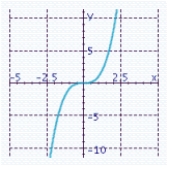 x-intercept: 0
x-intercept: 0
Y-intercept: 0
B)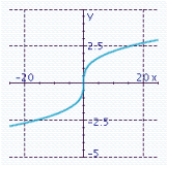 x-intercept: 0
x-intercept: 0
Y-intercept: 0
C)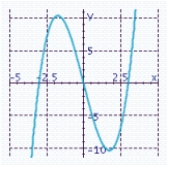 x-intercepts: -3, 0, 3
x-intercepts: -3, 0, 3
Y-intercept: 0
D) x-intercepts: -3, 0, 3
x-intercepts: -3, 0, 3
Y-intercept: 0
E)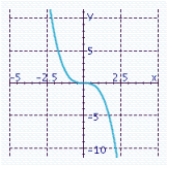 x-intercept: 0
x-intercept: 0
Y-intercept: 0
A)
 x-intercept: 0
x-intercept: 0Y-intercept: 0
B)
 x-intercept: 0
x-intercept: 0Y-intercept: 0
C)
 x-intercepts: -3, 0, 3
x-intercepts: -3, 0, 3Y-intercept: 0
D)
 x-intercepts: -3, 0, 3
x-intercepts: -3, 0, 3Y-intercept: 0
E)
 x-intercept: 0
x-intercept: 0Y-intercept: 0

فتح الحزمة
افتح القفل للوصول البطاقات البالغ عددها 25 في هذه المجموعة.
فتح الحزمة
k this deck
23
Sketch the graph of the rational function. Specify the intercepts and the asymptotes.
A) x-intercept: 3; y-intercept: - 1; vertical asymptote: x = - 3; horizontal asymptote: y = 1;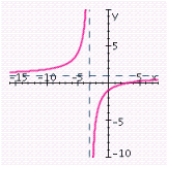
B) x-intercept: 0; y-intercept: - 1; vertical asymptote: x = 3; horizontal asymptote: y = - 1;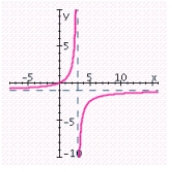
C) x-intercept: 3; y-intercept: 1; vertical asymptote: x = - 3; horizontal asymptote: y = - 1;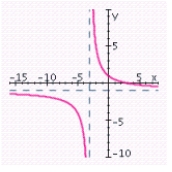
D) x-intercept: 3; y-intercept: - 1; vertical asymptote: x = 3; horizontal asymptote: y = - 1;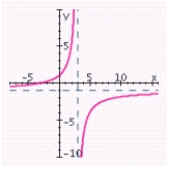
E) x-intercept: - 3; y-intercept: - 1; vertical asymptote: x = 3; horizontal asymptote: y = 1;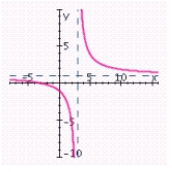
A) x-intercept: 3; y-intercept: - 1; vertical asymptote: x = - 3; horizontal asymptote: y = 1;

B) x-intercept: 0; y-intercept: - 1; vertical asymptote: x = 3; horizontal asymptote: y = - 1;

C) x-intercept: 3; y-intercept: 1; vertical asymptote: x = - 3; horizontal asymptote: y = - 1;

D) x-intercept: 3; y-intercept: - 1; vertical asymptote: x = 3; horizontal asymptote: y = - 1;

E) x-intercept: - 3; y-intercept: - 1; vertical asymptote: x = 3; horizontal asymptote: y = 1;


فتح الحزمة
افتح القفل للوصول البطاقات البالغ عددها 25 في هذه المجموعة.
فتح الحزمة
k this deck
24
Sketch the graph of the function and specify all x- and y-intercepts. y = x 3 (x + 1)
A)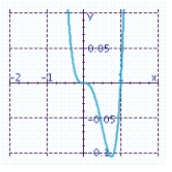 x-intercepts: 0, 1
x-intercepts: 0, 1
Y-intercept: 0
B)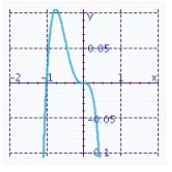 x-intercepts: 0, - 1
x-intercepts: 0, - 1
Y-intercept: 0
C)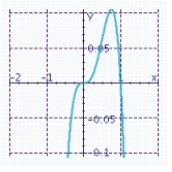 x-intercepts: 0, 1
x-intercepts: 0, 1
Y-intercept: 0
D)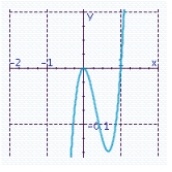 x-intercepts: 0, 1
x-intercepts: 0, 1
Y-intercept: 0
E)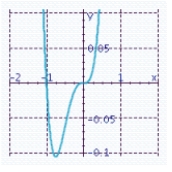 x-intercepts: 0, - 1
x-intercepts: 0, - 1
Y-intercept: 0
A)
 x-intercepts: 0, 1
x-intercepts: 0, 1Y-intercept: 0
B)
 x-intercepts: 0, - 1
x-intercepts: 0, - 1Y-intercept: 0
C)
 x-intercepts: 0, 1
x-intercepts: 0, 1Y-intercept: 0
D)
 x-intercepts: 0, 1
x-intercepts: 0, 1Y-intercept: 0
E)
 x-intercepts: 0, - 1
x-intercepts: 0, - 1Y-intercept: 0

فتح الحزمة
افتح القفل للوصول البطاقات البالغ عددها 25 في هذه المجموعة.
فتح الحزمة
k this deck
25
Sketch the graph of the rational function. Specify the intercepts and the asymptotes.
A) no x-intercepts; y-intercept: ; vertical asymptote: x = - 4; horizontal asymptote: y = 0;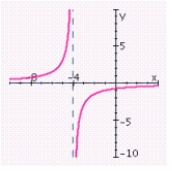
B) no x-intercepts; y-intercept: ; vertical asymptote: x = 4; horizontal asymptote: y = 0;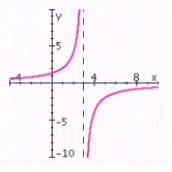
C) no x-intercepts; y-intercept: ; vertical asymptote: x = 4; horizontal asymptote: y = 0;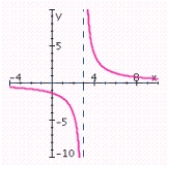
D) no x-intercepts; y-intercept: ; vertical asymptote: x = 4; horizontal asymptote: y = 0;
E) no x-intercepts; y-intercept: ; vertical asymptote: x = 4; horizontal asymptote: y = 0;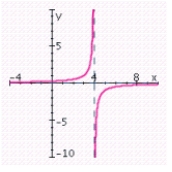
A) no x-intercepts; y-intercept: ; vertical asymptote: x = - 4; horizontal asymptote: y = 0;

B) no x-intercepts; y-intercept: ; vertical asymptote: x = 4; horizontal asymptote: y = 0;

C) no x-intercepts; y-intercept: ; vertical asymptote: x = 4; horizontal asymptote: y = 0;

D) no x-intercepts; y-intercept: ; vertical asymptote: x = 4; horizontal asymptote: y = 0;

E) no x-intercepts; y-intercept: ; vertical asymptote: x = 4; horizontal asymptote: y = 0;


فتح الحزمة
افتح القفل للوصول البطاقات البالغ عددها 25 في هذه المجموعة.
فتح الحزمة
k this deck








